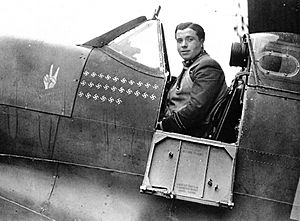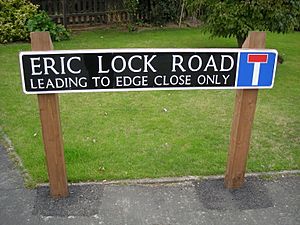Eric Lock facts for kids
Quick facts for kids
Eric Stanley Lock, DSO, DFC & Bar
|
|
|---|---|

Lock in the cockpit of his Spitfire. Just below the cockpit are 26 Swastika emblems denoting aerial victories. Lock has already recorded his final kill – on 14 July 1941. Shortly after this photo was taken, Lock disappeared.
|
|
| Nickname(s) | "Sawn Off" |
| Born | 19 April 1919 Bayston Hill, Shrewsbury, Shropshire, England |
| Died | 3 August 1941 (aged 22) English Channel, off Calais, France |
| Allegiance | United Kingdom |
| Service/ |
Royal Air Force |
| Years of service | 1939–1941 |
| Rank | Flight Lieutenant |
| Unit | No. 41 Squadron RAF No. 611 Squadron RAF |
| Battles/wars | Second World War
|
| Awards | Distinguished Service Order Distinguished Flying Cross & Bar |
Eric Stanley Lock (born April 19, 1919 – died August 3, 1941) was a brave British Royal Air Force (RAF) fighter pilot during World War II. He was known as a "flying ace," which means he shot down many enemy aircraft.
Born in Shrewsbury, England, Eric Lock joined the RAF in 1939. He quickly became a skilled pilot. In 1940, he joined No. 41 Squadron RAF and fought in the famous Battle of Britain. During this battle, he became the most successful pilot for the Allied forces, shooting down 21 German planes.
After the Battle of Britain, Lock continued to fly combat missions over France. He increased his total victories to 26 enemy aircraft. He was awarded the Distinguished Service Order (DSO) and the Distinguished Flying Cross (DFC) with a Bar, which are very important awards for bravery.
Eric Lock was nicknamed "Sawn Off Lockie" because he was quite short. In August 1941, he disappeared during a mission over the English Channel. His plane was likely hit by ground-fire. He was never found.
Early Life
Eric Stanley Lock was born in 1919. His family lived in the small village of Bayston Hill in Shropshire, England. They worked in farming and quarrying. Eric went to Prestfelde School in Shrewsbury.
When he was 14, his father took him for a short plane ride. But Eric wasn't very impressed by flying back then. At 16, he left school and started working in his family's business.
In 1939, as World War II seemed likely, Eric decided he wanted to be a fighter pilot. He joined the Royal Air Force Volunteer Reserve. He began his flight training soon after. By September 1939, when the war officially started, he was a trained pilot. He then joined No. 41 Squadron RAF at RAF Catterick, flying Spitfire planes.
Eric finished his training in May 1940. He was officially a fighter pilot. He took a short break in July 1940 to marry his girlfriend, Peggy Meyers. After his leave, he began flying patrols over northern England. He was protecting British airspace from German planes coming from Norway.
A Pilot in World War II
The Battle of Britain
The Battle of Britain started in July 1940. German planes, called the Luftwaffe, attacked British ships and the East Coast. Later, they began attacking RAF airfields in southern England. They wanted to control the skies over Britain. Lock's squadron was in the north, so they didn't see much action at first.
Eric Lock's first combat came on August 15, 1940. The Luftwaffe tried to attack targets in northern England. Lock spotted many German planes. He attacked a Messerschmitt Bf 110 fighter. After two short bursts of fire, its engine caught fire. He then shot down a Junkers Ju 88 bomber.
On September 3, 1940, Lock's squadron moved south to RAF Hornchurch in Essex. On September 5, he shot down two Heinkel He 111 bombers over the Thames Estuary. While chasing one, a Messerschmitt Bf 109 fighter attacked him. His Spitfire was damaged, and he was wounded in the leg. But Lock quickly turned the tables and shot down the Bf 109. He then helped rescue the crew of one of the He 111s he had shot down.
The next day, even with his injured leg, Lock shot down another Ju 88. On September 9, he claimed two more Bf 109s. By September 11, he had shot down nine enemy planes. He was awarded the Distinguished Flying Cross (DFC) for his bravery.
Lock continued to be very successful. On September 14, he shot down two more Bf 109s. On September 15, known as Battle of Britain Day, he shared in destroying a Dornier Do 17 and shot down another Bf 109. On September 20, he shot down a German reconnaissance plane over France. After this, he was awarded a Bar to his DFC, meaning he received the award a second time.
No. 41 Squadron took a rest period in October. But when Lock returned, he quickly added more victories. On October 20, 1940, he shot down a Bf 109 directly over RAF Biggin Hill. This brought his total to 20 victories. By the end of the Battle of Britain on October 31, 1940, Eric Lock had shot down 21 enemy aircraft. He was the most successful Allied pilot of the battle.
Flying Over the Channel
On November 8, 1940, Lock's Spitfire was badly damaged in a fight with Bf 109s. He had to crash-land in a field but was unhurt. On November 17, 1940, his squadron attacked 70 Bf 109s. After shooting down two, Lock's Spitfire was hit. He was badly injured in his right arm and both legs.
His plane's throttle was stuck open, making it fly very fast. With little control and badly hurt, Lock was in great danger. He managed to turn off the engine and glide his damaged plane to a safe landing near RAF Martlesham Heath. He was found by two soldiers and taken to a hospital.
He had lost a lot of blood and was unconscious. He had many operations to remove metal fragments from his wounds. While recovering, he was awarded the Distinguished Service Order (DSO) on December 17, 1940. This was for his "exceptional keenness and courage." He also visited Buckingham Palace to receive his awards from King George VI.
Final Missions
After several months in the hospital, Eric Lock returned to flying in June 1941. He was promoted to flying officer. A few weeks later, he became a flight lieutenant and joined No. 611 Squadron RAF. In July 1941, he shot down three more Bf 109s over France.
On August 3, 1941, Lock was returning from a mission. He saw German troops and vehicles on a road near Pas-de-Calais, France. He signaled to his wingman that he was going to attack them. He was seen diving towards the ground. This was the last time anyone saw him.
It is believed he was shot down by ground-fire. Neither his body nor his Spitfire plane were ever found. Eric Lock was declared "missing in action." This means he disappeared during a military operation and his fate is unknown. He was one of several famous RAF aces who were lost or captured around this time.
Remembering Eric Lock
There are several memorials to Eric Lock. You can find a stained glass memorial in Bayston Hill Memorial Hall in Shropshire, near where he grew up. There are also brass plaques in Condover Parish Church and at Prestfelde School chapel.
A road in Bayston Hill was named after him: Eric Lock Road. The members' bar at the Shropshire Aero Club, located at a former wartime airfield, is also named in his honor.
His name is carved on Panel 29 of the Runnymede Memorial. This memorial lists the names of over 20,000 British and Commonwealth airmen who went missing during the war. Eric Lock was also a member of the "Guinea Pig Club." This was a group of patients treated by a special plastic surgeon, Archibald McIndoe, for their injuries.


